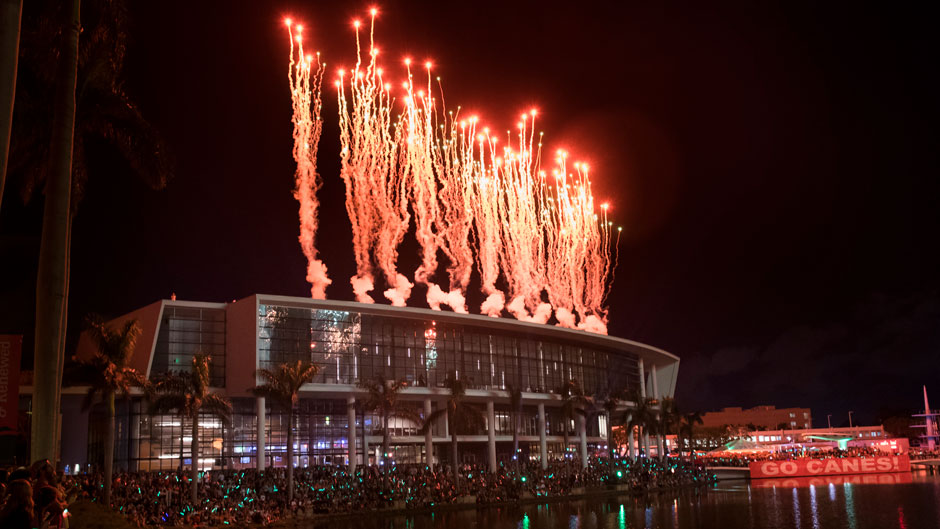From the persistent sound of drumming coming from the Iron Arrow Mound on the Foote University Green to ornaments dangling from the only orange tree on campus, it’s evident that Homecoming season is upon us. And with Homecoming comes a litany of traditions and festivities that you won’t find anywhere else but at the University of Miami.
’Canes from around the world – young and old – return to the Coral Gables campus to celebrate the future and honor the past while partaking in unique traditions. Since its first year in 1926, UM has established customs through events like Hurricane Howl, where alumni, students, faculty, staff and members of the community enjoy a block party before the parade takes its loop along Stanford Drive. This year former ’Canes defensive lineman, Greg Mark, has been selected as the grand marshal to lead the parade.
“Even our relatively young university has many time-honored traditions that have been passed on from one generation of ’Canes to the next,” said Josh Brandfon, director of Student Activities and Student Organizations and advisor to the Homecoming Executive Committee. “These special student-led traditions remind all ’Canes about UM’s adventure that lead us to where we are today as a thriving university with an engaged and spirited student body.”
’Canes proudly wear the colors orange, green, and white with honor but many may not be familiar with when and how the colors were selected. In 1926, the colors were chosen to represent the Florida orange tree. Orange symbolizes the fruit of the tree, green represents the leaves and white, the blossoms.
This year’s Spirit Tree Competition took place on Monday, Oct. 29, between the Bowman Foster Ashe Administration Building and the Dooley Memorial Classroom Building. Although small in stature, this campus landmark holds an immense significance to alumni, students, faculty, and staff. Each year the tree is decorated with custom-made ornaments by participating organizations. The Association of Commuter Students (ACS) won the yearly event.
On Thursday, Nov. 1, the Alma Mater Competition finalists will face-off on the University Center Rock Plaza for more than bragging rights. The winner will have the honor of singing the Alma Mater on the field during the Homecoming football game. In 1926, William Lampe wrote the words to the Alma Mater on the back of an envelope of an overdue bill from a printer and tapped pianist Christine Asdurian to compose the music. Nowadays, the Alma Mater is taught to all freshmen during orientation and sung during sporting events with pride.
When night falls on Friday, Nov. 2, all eyes will be on Lake Osceola as thousands of ’Canes gather for one of the University’s most cherished Homecoming traditions: the boat burning ceremony and fireworks. Legend has it that if the mast of the boat falls before the boat sinks, UM will win the Homecoming football game. This year, the Miami Hurricanes football team will take on the Duke Blue Devils at Hard Rock Stadium the following night.
In 1956, the boat burning tradition started as an effort to promote Theta Chi, a new fraternity on campus that year. At the time, Student Union Director Norman A. Whitten was looking for a student-run event to commemorate the 30th anniversary of Homecoming Week. In the 1960s, after years of boats being burned and settling at the bottom of Lake Osceola, environmental concerns grew. As a response, the boats were excavated and the event continued with environmentally-friendly materials from then on.
“Preparation for the boat burning ceremony was very fun and exciting,” said Obi Okolo, fireworks chair and member of the Homecoming Executive Committee. “Tia Black, the other fireworks chair, and I got to develop a fun and engaging script that highlights important aspects of UM traditions and the significance of the boat burning ceremony. We also placed an order for a pretty cool surprise for people in attendance!”
“I would consider that to be the most special and ‘unique-to-UM’ tradition,” said Brandfon. “Many schools do parades, block parties – but nobody is blowing up a boat on their lake!”
One of UM’s most sacred and established traditions is the gathering of Iron Arrow Honor Society members on the Mound atop the Foote Green. You won’t be able to miss them as they’re donned in their distinctly recognizable jackets, which are handcrafted by Miccosukee artisans. Founded in 1926 by University President Bowman Foster Ashe and student Francis Spencer Houghtailing, the society is a privileged honor. The Iron Arrow ritual and tradition was established through a relationship initially with the Seminole Nation, and currently with the Miccosukee Tribe of Indians of Florida.
“It’s always great to hear those stories about historic UM events and actually meeting the characters from those stories,” said Adrian Nuñez, chief of Iron Arrow. “This is the oldest running student organization UM has so it’s an honor to not only be welcoming back long-standing members but also tapping in new members as well.”
A new tradition is in motion this year as employees are invited to join in on the festivities. New events have been created just for them.
Sarah Artecona, associate vice president for community engagement, said, “As a big fan of my own university’s homecoming festivities, I always wondered if there was a place for non-UM graduates to join in the fun. Working with Student Affairs and Alumni Relations, we organized a number of ways employees can be part of the week of activities."

